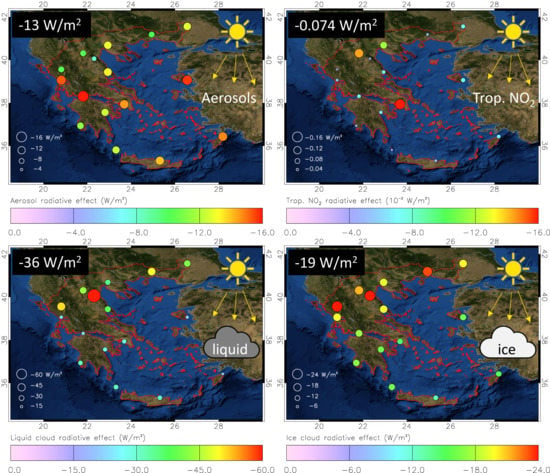Effect of Aerosols, Tropospheric NO2 and Clouds on Surface Solar Radiation over the Eastern Mediterranean (Greece)
Abstract
:1. Introduction
2. Data and Methods
2.1. Data
2.1.1. MODIS/Aqua Aerosol, Cloud, and Water Vapor Measurements
2.1.2. CALIOP/CALIPSO Aerosol Profiles and MACv2 Aerosol Climatology
2.1.3. OMI/Aura Tropospheric and Stratospheric NO2
2.1.4. CM SAF, CERES and Ground-Based SSR Data
2.1.5. Ancillary Data
2.2. Methodology
2.2.1. Data Aggregation
2.2.2. A System for Radiative Transfer Calculations—SBDART-NO2
2.2.3. Evaluation of SSR Data, Radiative Effects, and Trends
3. Results
3.1. SSR Data Evaluation
3.2. Radiative Effect of Aerosols, Tropospheric NO2 and Clouds
3.2.1. Annual
3.2.2. Seasonal
3.3. Trends
3.3.1. SSR Trends
3.3.2. Trends of the Aerosol, Tropospheric NO2 and Clouds Radiative Effect
4. Discussion
5. Conclusions
- Our monthly SSR simulations are in good agreement with the ground-based observations from three stations with quality-assured long time series (underestimation of −14.5 W/m2 or −7.5% with a very good correlation) and two satellite products, CM SAF SARAH-2.1 (−9.1%) and CERES EBAF edition 4.1 (−7.2%);
- The annual all-sky radiative effect of aerosols (REaer) and tropospheric NO2 (RENO2) on SSR for the 16 locations in Greece is −13 W/m2 and −0.074 W/m2, respectively. Liquid clouds dominate, with an average RElc of −36 W/m2, and ice clouds follow (REic of −19 W/m2). RENO2 is smaller, by two orders of magnitude, compared to that of aerosols and clouds, and hence is negligible;
- On average, higher annual REaer values (by ~2 W/m2) appear over urban locations compared to rural locations. The annual REaer ranges from −18 W/m2 (Patras) to −8 W/m2 (Olympus). The annual RENO2 over urban locations (−0.113 W/m2) is double the ones over rural locations, with the highest values appearing over the three pollution hot spots in the area, namely, Athens (−0.166 W/m2), Kozani (−0.144 W/m2), and Thessaloniki (−0.118 W/m2). The annual RElc ranges spatially from −79 W/m2 (Olympus) to −21 W/m2 (Rhodes), while REic ranges from −26 W/m2 (Ioannina) to −13 W/m2 (HCMR);
- The annual average REaer for all the locations under clear skies (−18 W/m2) is about 3–4 times larger than for liquid (−5 W/m2) and ice (−6 W/m2) cloud-covered skies; for individual locations, it can be up to 4–5 times larger (e.g., Olympus). For tropospheric NO2, the average RENO2 under clear skies (−0.095 W/m2) is double that for liquid (−0.045 W/m2) and ice (−0.051 W/m2) cloud-covered skies;
- REaer peaks in the spring and summer, with the maximum values (up to −30 W/m2 for some locations) appearing in August over all the 16 locations. During the winter, especially in December and January, REaer generally drops below −5 W/m2 and in some cases reaches values around −1 W/m2. RENO2 peaks in July, with the highest values appearing over Athens (−0.215 W/m2), which is still very low to play a substantial role in the local radiative budget;
- The lowest RElc (−1 W/m2) appears in July over Rhodes, and the highest RElc (−123 W/m2) appears in May over Olympus. REic is very low in the summer (July and August), ranging from −2 to 0 W/m2 for 9 out of the 16 locations. The highest REic value appears in May over Ioannina (−44 W/m2);
- Positive SSR trends (increase), ranging from 0.01 W/m2/year (Rhodes) to 0.52 W/m2/year (Olympus), appear over all the locations for the period 2005–2019, except for two, which are Mytilene (−0.27 W/m2/year or −0.14%/year) and HCMR (−0.12 W/m2/year or −0.06%/year). Over the two locations with the strongest trends, Volos (0.78 W/m2/year or 0.45%/year) and Thessaloniki (0.67 W/m2/year or 0.40%/year), the trends are statistically significant at the 95% confidence level. Our SSR trends, in general, agree with those of CM SAF (2005–2017) and CERES (2005–2019), indicating an increase in SSR over Athens and Thessaloniki, which is in agreement to the ground observations;
- The general decrease in AOD550 (trends ranging from −0.005/year to zero depending on the location) and liquid cloud fraction (trends ranging from −0.006/year to −0.001/year) drives the positive SSR trends observed in the area for the period 2005–2019. The strongest REaer magnitude trends appear over the urban locations of Patras (−0.35 W/m2/year or −1.74%/year) and Thessaloniki (−0.31 W/m2/year or −2.05%/year), and the strongest RElc magnitude trend is found over the urban location of Volos (−0.80 W/m2/year or −1.78%/year). These three trend values are statistically significant at the 95% confidence level;
- The effect of tropospheric NO2 on the SSR trends is negligible. Negative RENO2 magnitude trends (statistically significant for some locations only) are found over all the locations except for one (Antikythera). The negative RENO2 magnitude trends reflect the negative trends of tropospheric NO2. The strongest tropospheric NO2 trends (also statistically significant) are seen over the urban locations of Kozani (−0.21 × 1015 molecules/cm2/year or −3.95%/year), Athens (−0.19 × 1015 molecules/cm2/year or −3.57%/year), and Thessaloniki (−0.11 × 1015 molecules/cm2/year or −2.89%/year);
- Contrary to liquid clouds, the REic magnitude exhibits positive trends over all the locations except for one (Rhodes). Argos exhibits the strongest trend (0.46 W/m2/year or 3.57%/year), being also the only location with a statistically significant trend. The positive REic magnitude trends follow the positive ice cloud fraction trends (ranging from zero to 0.003/year depending on the location);
- The liquid and ice cloud optical thickness has increased for some stations, while for others it has decreased during 2005–2019, suppressing or boosting the changes in the radiative effect of clouds, which are induced by changes in the liquid and ice cloud fractions.
Supplementary Materials
Author Contributions
Funding
Institutional Review Board Statement
Informed Consent Statement
Data Availability Statement
Acknowledgments
Conflicts of Interest
References
- Teuling, A.J.; Hirschi, M.; Ohmura, A.; Wild, M.; Reichstein, M.; Ciais, P.; Buchmann, N.; Ammann, C.; Montagnani, L.; Richardson, A.D.; et al. A Regional Perspective on Trends in Continental Evaporation: EVAPORATION TRENDS. Geophys. Res. Lett. 2009, 36. [Google Scholar] [CrossRef] [Green Version]
- Ramanathan, V. Aerosols, Climate, and the Hydrological Cycle. Science 2001, 294, 2119–2124. [Google Scholar] [CrossRef] [PubMed] [Green Version]
- Wild, M.; Liepert, B. The Earth Radiation Balance as Driver of the Global Hydrological Cycle. Environ. Res. Lett. 2010, 5, 025203. [Google Scholar] [CrossRef]
- Gu, L.; Baldocchi, D.; Verma, S.B.; Black, T.A.; Vesala, T.; Falge, E.M.; Dowty, P.R. Advantages of Diffuse Radiation for Terrestrial Ecosystem Productivity: ADVANTAGES OF DIFFUSE RADIATION. J. Geophys. Res. Atmos. 2002, 107, ACL 2-1-ACL 2-23. [Google Scholar] [CrossRef] [Green Version]
- Mercado, L.M.; Bellouin, N.; Sitch, S.; Boucher, O.; Huntingford, C.; Wild, M.; Cox, P.M. Impact of Changes in Diffuse Radiation on the Global Land Carbon Sink. Nature 2009, 458, 1014–1017. [Google Scholar] [CrossRef] [Green Version]
- Wild, M.; Folini, D.; Schär, C.; Loeb, N.; Dutton, E.G.; König-Langlo, G. The Global Energy Balance from a Surface Perspective. Clim. Dyn. 2013, 40, 3107–3134. [Google Scholar] [CrossRef] [Green Version]
- Wild, M. Decadal Changes in Radiative Fluxes at Land and Ocean Surfaces and Their Relevance for Global Warming. Wiley Interdiscip. Rev. Clim. Change. 2016, 7, 91–107. [Google Scholar] [CrossRef]
- Katragkou, E.; García-Díez, M.; Vautard, R.; Sobolowski, S.; Zanis, P.; Alexandri, G.; Cardoso, R.M.; Colette, A.; Fernandez, J.; Gobiet, A.; et al. Regional Climate Hindcast Simulations within EURO-CORDEX: Evaluation of a WRF Multi-Physics Ensemble. Geosci. Model Dev. 2015, 8, 603–618. [Google Scholar] [CrossRef] [Green Version]
- Hammer, A.; Heinemann, D.; Hoyer, C.; Kuhlemann, R.; Lorenz, E.; Müller, R.; Beyer, H.G. Solar Energy Assessment Using Remote Sensing Technologies. Remote Sens. Environ. 2003, 86, 423–432. [Google Scholar] [CrossRef]
- Wild, M.; Ohmura, A.; Schär, C.; Müller, G.; Folini, D.; Schwarz, M.; Hakuba, M.Z.; Sanchez-Lorenzo, A. The Global Energy Balance Archive (GEBA) Version 2017: A Database for Worldwide Measured Surface Energy Fluxes. Earth Syst. Sci. Data 2017, 9, 601–613. [Google Scholar] [CrossRef] [Green Version]
- Driemel, A.; Augustine, J.; Behrens, K.; Colle, S.; Cox, C.; Cuevas-Agulló, E.; Denn, F.M.; Duprat, T.; Fukuda, M.; Grobe, H.; et al. Baseline Surface Radiation Network (BSRN): Structure and Data Description (1992–2017). Earth Syst. Sci. Data 2018, 10, 1491–1501. [Google Scholar] [CrossRef] [Green Version]
- Pinker, R.T. Do Satellites Detect Trends in Surface Solar Radiation? Science 2005, 308, 850–854. [Google Scholar] [CrossRef] [Green Version]
- Rossow, W.B.; Zhang, Y.-C. Calculation of Surface and Top of Atmosphere Radiative Fluxes from Physical Quantities Based on ISCCP Data Sets: 2. Validation and First Results. J. Geophys. Res. Atmos. 1995, 100, 1167–1197. [Google Scholar] [CrossRef]
- Zhang, Y.; Rossow, W.B.; Lacis, A.; Oinas, V.; Mishchenko, M.I. Calculation of Radiative Fluxes from the Surface to Top of Atmosphere Based on ISCCP and Other Global Data Sets: Refinements of the Radiative Transfer Model and the Input Data. J. Geophys. Res. 2004, 109, D19105. [Google Scholar] [CrossRef] [Green Version]
- Hatzianastassiou, N.; Matsoukas, C.; Fotiadi, A.; Pavlakis, K.G.; Drakakis, E.; Hatzidimitriou, D.; Vardavas, I. Global Distribution of Earth’s Surface Shortwave Radiation Budget. Atmos. Chem. Phys. 2005, 5, 2847–2867. [Google Scholar] [CrossRef] [Green Version]
- Kim, D.; Ramanathan, V. Solar Radiation Budget and Radiative Forcing Due to Aerosols and Clouds. J. Geophys. Res. 2008, 113, D02203. [Google Scholar] [CrossRef] [Green Version]
- Wang, H.; Pinker, R.T. Shortwave Radiative Fluxes from MODIS: Model Development and Implementation. J. Geophys. Res. 2009, 114, D20201. [Google Scholar] [CrossRef]
- Müller, R.; Pfeifroth, U.; Träger-Chatterjee, C.; Trentmann, J.; Cremer, R. Digging the METEOSAT Treasure—3 Decades of Solar Surface Radiation. Remote Sens. 2015, 7, 8067–8101. [Google Scholar] [CrossRef] [Green Version]
- Wang, Y.; Lyu, R.; Xie, X.; Meng, Z.; Huang, M.; Wu, J.; Mu, H.; Yu, Q.-R.; He, Q.; Cheng, T. Retrieval of Gridded Aerosol Direct Radiative Forcing Based on Multiplatform Datasets. Atmos. Meas. Tech. 2020, 13, 575–592. [Google Scholar] [CrossRef]
- Giorgi, F. Climate Change Hot-Spots. Geophys. Res. Lett. 2006, 33, L08707. [Google Scholar] [CrossRef]
- Papadimas, C.D.; Hatzianastassiou, N.; Matsoukas, C.; Kanakidou, M.; Mihalopoulos, N.; Vardavas, I. The Direct Effect of Aerosols on Solar Radiation over the Broader Mediterranean Basin. Atmos. Chem. Phys. 2012, 12, 7165–7185. [Google Scholar] [CrossRef] [Green Version]
- Pyrina, M.; Hatzianastassiou, N.; Matsoukas, C.; Fotiadi, A.; Papadimas, C.D.; Pavlakis, K.G.; Vardavas, I. Cloud Effects on the Solar and Thermal Radiation Budgets of the Mediterranean Basin. Atmos. Res. 2015, 152, 14–28. [Google Scholar] [CrossRef]
- Mateos, D.; Sanchez-Lorenzo, A.; Antón, M.; Cachorro, V.E.; Calbó, J.; Costa, M.J.; Torres, B.; Wild, M. Quantifying the Respective Roles of Aerosols and Clouds in the Strong Brightening since the Early 2000s over the Iberian Peninsula: RECENT BRIGHTENING BY CLOUDS AND AEROSOL. J. Geophys. Res. Atmos. 2014, 119, 10382–10393. [Google Scholar] [CrossRef] [Green Version]
- Obregón, M.Á.; Serrano, A.; Costa, M.J.; Silva, A.M. Global Spatial and Temporal Variation of the Combined Effect of Aerosol and Water Vapour on Solar Radiation. Remote Sens. 2021, 13, 708. [Google Scholar] [CrossRef]
- Hatzianastassiou, N.; Gkikas, A.; Mihalopoulos, N.; Torres, O.; Katsoulis, B.D. Natural versus Anthropogenic Aerosols in the Eastern Mediterranean Basin Derived from Multiyear TOMS and MODIS Satellite Data. J. Geophys. Res. 2009, 114, D24202. [Google Scholar] [CrossRef]
- Georgoulias, A.K.; Alexandri, G.; Kourtidis, K.A.; Lelieveld, J.; Zanis, P.; Pöschl, U.; Levy, R.; Amiridis, V.; Marinou, E.; Tsikerdekis, A. Spatiotemporal Variability and Contribution of Different Aerosol Types to the Aerosol Optical Depth over the Eastern Mediterranean. Atmos. Chem. Phys. 2016, 16, 13853–13884. [Google Scholar] [CrossRef] [PubMed] [Green Version]
- Alexandri, G.; Georgoulias, A.K.; Meleti, C.; Balis, D.; Kourtidis, K.A.; Sanchez-Lorenzo, A.; Trentmann, J.; Zanis, P. A High Resolution Satellite View of Surface Solar Radiation over the Climatically Sensitive Region of Eastern Mediterranean. Atmos. Res. 2017, 188, 107–121. [Google Scholar] [CrossRef]
- Antón, M.; Mateos, D. Shortwave Radiative Forcing Due to Long-Term Changes of Total Ozone Column over the Iberian Peninsula. Atmos. Environ. 2013, 81, 532–537. [Google Scholar] [CrossRef]
- Solomon, S.; Portmann, R.W.; Sanders, R.W.; Daniel, J.S.; Madsen, W.; Bartram, B.; Dutton, E.G. On the Role of Nitrogen Dioxide in the Absorption of Solar Radiation. J. Geophys. Res. Atmos. 1999, 104, 12047–12058. [Google Scholar] [CrossRef]
- Vasilkov, A.P.; Joiner, J.; Oreopoulos, L.; Gleason, J.F.; Veefkind, P.; Bucsela, E.; Celarier, E.A.; Spurr, R.J.D.; Platnick, S. Impact of Tropospheric Nitrogen Dioxide on the Regional Radiation Budget. Atmos. Chem. Phys. 2009, 9, 6389–6400. [Google Scholar] [CrossRef] [Green Version]
- Lohmann, U.; Feichter, J. Global Indirect Aerosol Effects: A Review. Atmos. Chem. Phys. 2005, 5, 715–737. [Google Scholar] [CrossRef] [Green Version]
- Georgoulias, A.K.; van der A, R.J.; Stammes, P.; Boersma, K.F.; Eskes, H.J. Trends and Trend Reversal Detection in 2 Decades of Tropospheric NO2 Satellite Observations. Atmos. Chem. Phys. 2019, 19, 6269–6294. [Google Scholar] [CrossRef] [Green Version]
- Salomonson, V.V.; Barnes, W.L.; Maymon, P.W.; Montgomery, H.E.; Ostrow, H. MODIS: Advanced Facility Instrument for Studies of the Earth as a System. IEEE Trans. Geosci. Remote Sens. 1989, 27, 145–153. [Google Scholar] [CrossRef]
- Kaufman, Y.J.; Tanré, D.; Remer, L.A.; Vermote, E.F.; Chu, A.; Holben, B.N. Operational Remote Sensing of Tropospheric Aerosol over Land from EOS Moderate Resolution Imaging Spectroradiometer. J. Geophys. Res. Atmos. 1997, 102, 17051–17067. [Google Scholar] [CrossRef]
- Remer, L.A.; Kaufman, Y.J.; Tanré, D.; Mattoo, S.; Chu, D.A.; Martins, J.V.; Li, R.-R.; Ichoku, C.; Levy, R.C.; Kleidman, R.G.; et al. The MODIS Aerosol Algorithm, Products, and Validation. J. Atmos. Sci. 2005, 62, 947–973. [Google Scholar] [CrossRef] [Green Version]
- Levy, R.C.; Remer, L.A.; Kleidman, R.G.; Mattoo, S.; Ichoku, C.; Kahn, R.; Eck, T.F. Global Evaluation of the Collection 5 MODIS Dark-Target Aerosol Products over Land. Atmos. Chem. Phys. 2010, 10, 10399–10420. [Google Scholar] [CrossRef] [Green Version]
- Levy, R.C.; Mattoo, S.; Munchak, L.A.; Remer, L.A.; Sayer, A.M.; Patadia, F.; Hsu, N.C. The Collection 6 MODIS Aerosol Products over Land and Ocean. Atmos. Meas. Tech. 2013, 6, 2989–3034. [Google Scholar] [CrossRef] [Green Version]
- Tanré, D.; Kaufman, Y.J.; Herman, M.; Mattoo, S. Remote Sensing of Aerosol Properties over Oceans Using the MODIS/EOS Spectral Radiances. J. Geophys. Res. Atmos. 1997, 102, 16971–16988. [Google Scholar] [CrossRef]
- Sayer, A.M.; Hsu, N.C.; Bettenhausen, C.; Jeong, M.-J. Validation and Uncertainty Estimates for MODIS Collection 6 “Deep Blue” Aerosol Data: DEEP BLUE COLLECTION 6 VALIDATION. J. Geophys. Res. Atmos. 2013, 118, 7864–7872. [Google Scholar] [CrossRef] [Green Version]
- Sayer, A.M.; Munchak, L.A.; Hsu, N.C.; Levy, R.C.; Bettenhausen, C.; Jeong, M.-J. MODIS Collection 6 Aerosol Products: Comparison between Aqua’s e-Deep Blue, Dark Target, and “Merged” Data Sets, and Usage Recommendations. J. Geophys. Res. Atmos. 2014, 119, 965–13,989. [Google Scholar] [CrossRef]
- Sayer, A.M.; Hsu, N.C.; Bettenhausen, C.; Jeong, M.-J.; Meister, G. Effect of MODIS Terra Radiometric Calibration Improvements on Collection 6 Deep Blue Aerosol Products: Validation and Terra/Aqua Consistency. J. Geophys. Res. Atmos. 2015, 120. [Google Scholar] [CrossRef] [Green Version]
- Hsu, N.C.; Jeong, M.-J.; Bettenhausen, C.; Sayer, A.M.; Hansell, R.; Seftor, C.S.; Huang, J.; Tsay, S.-C. Enhanced Deep Blue Aerosol Retrieval Algorithm: The Second Generation: ENHANCED DEEP BLUE AEROSOL RETRIEVAL. J. Geophys. Res. Atmos. 2013, 118, 9296–9315. [Google Scholar] [CrossRef]
- Hsu, N.C.; Lee, J.; Sayer, A.M.; Kim, W.; Bettenhausen, C.; Tsay, S.-C. VIIRS Deep Blue Aerosol Products Over Land: Extending the EOS Long-Term Aerosol Data Records. J. Geophys. Res. Atmos. 2019, 124, 4026–4053. [Google Scholar] [CrossRef]
- Sayer, A.M.; Hsu, N.C.; Lee, J.; Kim, W.V.; Dutcher, S.T. Validation, Stability, and Consistency of MODIS Collection 6.1 and VIIRS Version 1 Deep Blue Aerosol Data Over Land. J. Geophys. Res. Atmos. 2019, 124, 4658–4688. [Google Scholar] [CrossRef]
- Platnick, S.; Meyer, K.G.; King, M.D.; Wind, G.; Amarasinghe, N.; Marchant, B.; Arnold, G.T.; Zhang, Z.; Hubanks, P.A.; Holz, R.E.; et al. The MODIS Cloud Optical and Microphysical Products: Collection 6 Updates and Examples From Terra and Aqua. IEEE Trans. Geosci. Remote Sens. 2017, 55, 502–525. [Google Scholar] [CrossRef] [Green Version]
- Ackerman, S.A.; Strabala, K.I.; Menzel, W.P.; Frey, R.A.; Moeller, C.C.; Gumley, L.E. Discriminating Clear Sky from Clouds with MODIS. J. Geophys. Res. Atmos. 1998, 103, 32141–32157. [Google Scholar] [CrossRef]
- King, M.D.; Menzel, W.P.; Kaufman, Y.J.; Tanre, D.; Gao, B.-C.; Platnick, S.; Ackerman, S.A.; Remer, L.A.; Pincus, R.; Hubanks, P.A. Cloud and Aerosol Properties, Precipitable Water, and Profiles of Temperature and Water Vapor from MODIS. IEEE Trans. Geosci. Remote Sens. 2003, 41, 442–458. [Google Scholar] [CrossRef] [Green Version]
- Platnick, S.; King, M.D.; Ackerman, S.A.; Menzel, W.P.; Baum, B.A.; Riedi, J.C.; Frey, R.A. The MODIS Cloud Products: Algorithms and Examples from Terra. IEEE Trans. Geosci. Remote Sens. 2003, 41, 459–473. [Google Scholar] [CrossRef] [Green Version]
- Frey, R.A.; Ackerman, S.A.; Liu, Y.; Strabala, K.I.; Zhang, H.; Key, J.R.; Wang, X. Cloud Detection with MODIS. Part I: Improvements in the MODIS Cloud Mask for Collection 5. J. Atmospheric Ocean. Technol. 2008, 25, 1057–1072. [Google Scholar] [CrossRef]
- Marchant, B.; Platnick, S.; Meyer, K.; Arnold, G.T.; Riedi, J. MODIS Collection 6 Shortwave-Derived Cloud Phase Classification Algorithm and Comparisons with CALIOP. Atmos. Meas. Tech. 2016, 9, 1587–1599. [Google Scholar] [CrossRef] [Green Version]
- Nakajima, T.; King, M.D. Determination of the Optical Thickness and Effective Particle Radius of Clouds from Reflected Solar Radiation Measurements. Part I: Theory. J. Atmos. Sci. 1990, 47, 1878–1893. [Google Scholar] [CrossRef] [Green Version]
- Menzel, W.P.; Frey, R.A.; Zhang, H.; Wylie, D.P.; Moeller, C.C.; Holz, R.E.; Maddux, B.; Baum, B.A.; Strabala, K.I.; Gumley, L.E. MODIS Global Cloud-Top Pressure and Amount Estimation: Algorithm Description and Results. J. Appl. Meteorol. Climatol. 2008, 47, 1175–1198. [Google Scholar] [CrossRef] [Green Version]
- Baum, B.A.; Menzel, W.P.; Frey, R.A.; Tobin, D.C.; Holz, R.E.; Ackerman, S.A.; Heidinger, A.K.; Yang, P. MODIS Cloud-Top Property Refinements for Collection 6. J. Appl. Meteorol. Climatol. 2012, 51, 1145–1163. [Google Scholar] [CrossRef]
- Kinne, S. The MACv2 Aerosol Climatology. Tellus B Chem. Phys. Meteorol. 2019, 71, 1–21. [Google Scholar] [CrossRef] [Green Version]
- Winker, D.M.; Vaughan, M.A.; Omar, A.; Hu, Y.; Powell, K.A.; Liu, Z.; Hunt, W.H.; Young, S.A. Overview of the CALIPSO Mission and CALIOP Data Processing Algorithms. J. Atmos. Ocean. Technol. 2009, 26, 2310–2323. [Google Scholar] [CrossRef]
- Hunt, W.H.; Winker, D.M.; Vaughan, M.A.; Powell, K.A.; Lucker, P.L.; Weimer, C. CALIPSO Lidar Description and Performance Assessment. J. Atmos. Ocean. Technol. 2009, 26, 1214–1228. [Google Scholar] [CrossRef]
- Tackett, J.L.; Winker, D.M.; Getzewich, B.J.; Vaughan, M.A.; Young, S.A.; Kar, J. CALIPSO Lidar Level 3 Aerosol Profile Product: Version 3 Algorithm Design. Atmos. Meas. Tech. 2018, 11, 4129–4152. [Google Scholar] [CrossRef] [Green Version]
- Young, S.A.; Vaughan, M.A.; Garnier, A.; Tackett, J.L.; Lambeth, J.D.; Powell, K.A. Extinction and Optical Depth Retrievals for CALIPSO’s Version 4 Data Release. Atmos. Meas. Tech. 2018, 11, 5701–5727. [Google Scholar] [CrossRef] [Green Version]
- Boersma, K.F.; Eskes, H.J.; Richter, A.; De Smedt, I.; Lorente, A.; Beirle, S.; van Geffen, J.H.G.M.; Zara, M.; Peters, E.; Van Roozendael, M.; et al. Improving Algorithms and Uncertainty Estimates for Satellite NO2 Retrievals: Results from the Quality Assurance for the Essential Climate Variables (QA4ECV) Project. Atmos. Meas. Tech. 2018, 11, 6651–6678. [Google Scholar] [CrossRef] [Green Version]
- Levelt, P.F.; Joiner, J.; Tamminen, J.; Veefkind, J.P.; Bhartia, P.K.; Stein Zweers, D.C.; Duncan, B.N.; Streets, D.G.; Eskes, H.; van der A, R.; et al. The Ozone Monitoring Instrument: Overview of 14 Years in Space. Atmos. Chem. Phys. 2018, 18, 5699–5745. [Google Scholar] [CrossRef] [Green Version]
- Lorente, A.; Folkert Boersma, K.; Yu, H.; Dörner, S.; Hilboll, A.; Richter, A.; Liu, M.; Lamsal, L.N.; Barkley, M.; De Smedt, I.; et al. Structural Uncertainty in Air Mass Factor Calculation for NO2 and HCHO Satellite Retrievals. Atmos. Meas. Tech. 2017, 10, 759–782. [Google Scholar] [CrossRef] [Green Version]
- Zara, M.; Boersma, K.F.; De Smedt, I.; Richter, A.; Peters, E.; van Geffen, J.H.G.M.; Beirle, S.; Wagner, T.; Van Roozendael, M.; Marchenko, S.; et al. Improved Slant Column Density Retrieval of Nitrogen Dioxide and Formaldehyde for OMI and GOME-2A from QA4ECV: Intercomparison, Uncertainty Characterisation, and Trends. Atmos. Meas. Tech. 2018, 11, 4033–4058. [Google Scholar] [CrossRef] [Green Version]
- Pinardi, G.; Van Roozendael, M.; Hendrick, F.; Theys, N.; Abuhassan, N.; Bais, A.; Boersma, F.; Cede, A.; Chong, J.; Donner, S.; et al. Validation of Tropospheric NO2 Column Measurements of GOME-2A and OMI Using MAX-DOAS and Direct Sun Network Observations. Atmos. Meas. Tech. 2020, 13, 6141–6174. [Google Scholar] [CrossRef]
- Compernolle, S.; Verhoelst, T.; Pinardi, G.; Granville, J.; Hubert, D.; Keppens, A.; Niemeijer, S.; Rino, B.; Bais, A.; Beirle, S.; et al. Validation of Aura-OMI QA4ECV NO2 Climate Data Records with Ground-Based DOAS Networks: The Role of Measurement and Comparison Uncertainties. Atmos. Chem. Phys. 2020, 20, 8017–8045. [Google Scholar] [CrossRef]
- Pfeifroth, U.; Kothe, S.; Trentmann, J.; Hollmann, R.; Fuchs, P.; Kaiser, J.; Werscheck, M. Surface Radiation Data Set—Heliosat (SARAH)—Edition 2.1; Satellite Application Facility on Climate Monitoring: Offenbach, Germany, 2019. [Google Scholar] [CrossRef]
- Pfeifroth, U.; Sanchez-Lorenzo, A.; Manara, V.; Trentmann, J.; Hollmann, R. Trends and Variability of Surface Solar Radiation in Europe Based On Surface- and Satellite-Based Data Records. J. Geophys. Res. Atmos. 2018, 123, 1735–1754. [Google Scholar] [CrossRef]
- Loeb, N.G.; Doelling, D.R.; Wang, H.; Su, W.; Nguyen, C.; Corbett, J.G.; Liang, L.; Mitrescu, C.; Rose, F.G.; Kato, S. Clouds and the Earth’s Radiant Energy System (CERES) Energy Balanced and Filled (EBAF) Top-of-Atmosphere (TOA) Edition-4.0 Data Product. J. Clim. 2018, 31, 895–918. [Google Scholar] [CrossRef]
- Kato, S.; Rose, F.G.; Rutan, D.A.; Thorsen, T.J.; Loeb, N.G.; Doelling, D.R.; Huang, X.; Smith, W.L.; Su, W.; Ham, S.-H. Surface Irradiances of Edition 4.0 Clouds and the Earth’s Radiant Energy System (CERES) Energy Balanced and Filled (EBAF) Data Product. J. Clim. 2018, 31, 4501–4527. [Google Scholar] [CrossRef]
- Wielicki, B.A.; Barkstrom, B.R.; Harrison, E.F.; Lee III, R.B.; Smith, G.L.; Cooper, J.E. Clouds and the Earth’s Radiant Energy System (CERES): An Earth Observing System Experiment. Bull. Am. Meteorol. Soc. 1996, 77, 853–868. [Google Scholar] [CrossRef] [Green Version]
- Loeb, N.G.; Priestley, K.J.; Kratz, D.P.; Geier, E.B.; Green, R.N.; Wielicki, B.A.; Hinton, P.O.; Nolan, S.K. Determination of Unfiltered Radiances from the Clouds and the Earth’s Radiant Energy System Instrument. J. Appl. Meteorol. Climatol. 2001, 40, 822–835 14. [Google Scholar] [CrossRef]
- Su, W.; Corbett, J.; Eitzen, Z.; Liang, L. Next-Generation Angular Distribution Models for Top-of-Atmosphere Radiative Flux Calculation from CERES Instruments: Methodology. Atmos. Meas. Tech. 2015, 8, 611–632. [Google Scholar] [CrossRef] [Green Version]
- Bais, A.F.; Drosoglou, T.; Meleti, C.; Tourpali, K.; Kouremeti, N. Changes in Surface Shortwave Solar Irradiance from 1993 to 2011 at Thessaloniki (Greece): SHORTWAVE DOWNWARD SOLAR IRRADIANCE TREND. Int. J. Climatol. 2013, 33, 2871–2876. [Google Scholar] [CrossRef] [Green Version]
- Kazadzis, S.; Founda, D.; Psiloglou, B.E.; Kambezidis, H.; Mihalopoulos, N.; Sanchez-Lorenzo, A.; Meleti, C.; Raptis, P.I.; Pierros, F.; Nabat, P. Long-Term Series and Trends in Surface Solar Radiation in Athens, Greece. Atmos. Chem. Phys. 2018, 18, 2395–2411. [Google Scholar] [CrossRef] [Green Version]
- Bhartia, P.K. OMI/Aura TOMS-Like Ozone, Aerosol Index, Cloud Radiance Fraction Daily L3 Global 1.0 × 1.0 Deg; Goddard Earth Sciences Data and Information Services Center: Greenbelt, MD, USA, 2012. [CrossRef]
- Karlsson, K.-G.; Anttila, K.; Trentmann, J.; Stengel, M.; Solodovnik, I.; Meirink, J.F.; Devasthale, A.; Kothe, S.; Jääskeläinen, E.; Sedlar, J.; et al. CLARA-A2.1: CM SAF CLoud, Albedo and Surface RAdiation Dataset from AVHRR Data—Edition 2.1; Satellite Application Facility on Climate Monitoring: Offenbach, Germany, 2020. [Google Scholar] [CrossRef]
- Finkensieper, S.; Meirink, J.F.; van Zadelhoff, G.-J.; Hanschmann, T.; Benas, N.; Stengel, M.; Fuchs, P.; Hollmann, R.; Kaiser, J.; Werscheck, M. CLAAS-2.1: CM SAF CLoud Property DAtAset Using SEVIRI—Edition 2.1; Satellite Application Facility on Climate Monitoring: Offenbach, Germany, 2020. [Google Scholar] [CrossRef]
- Danielson, J.J.; Gesch, D.B. Global Multi-Resolution Terrain Elevation Data 2010 (GMTED2010). US Geol. Surv. 2011, 23. [Google Scholar] [CrossRef]
- Center For International Earth Science Information Network-CIESIN-Columbia University Gridded Population of the World, Version 4 (GPWv4): Population Count, Revision 11; CIESIN: New York, NY, USA, 2018. [CrossRef]
- Ricchiazzi, P.; Yang, S.; Gautier, C.; Sowle, D. SBDART: A Research and Teaching Software Tool for Plane-Parallel Radiative Transfer in the Earth’s Atmosphere. Bull. Am. Meteorol. Soc. 1998, 79, 2101–2114. [Google Scholar] [CrossRef] [Green Version]
- Hatzianastassiou, N.; Vardavas, I. Shortwave Radiation Budget of the Northern Hemisphere Using International Satellite Cloud Climatology Project and NCEP/NCAR Climatological Data. J. Geophys. Res. Atmos. 1999, 104, 24401–24421. [Google Scholar] [CrossRef] [Green Version]
- McClatchey, R.A.; Fenn, R.W.; Shelby, J.E.A.; Voltz, F.E.; Garing, J.S. Optical Properties of the Atmosphere; AFCRL-71-0279; Air Force Geophysics Laboratory: Bedford, MA, USA, 1972. [Google Scholar]
- Korolev, A.; Isaac, G.A. Relative Humidity in Liquid, Mixed-Phase, and Ice Clouds. J. Atmos. Sci. 2006, 63, 2865–2880. [Google Scholar] [CrossRef] [Green Version]
- Burrows, J.P.; Dehn, A.; Deters, B.; Himmelmann, S.; Richter, A.; Voigt, S.; Orphal, J. Atmospheric remote-sensing reference data from gome: Part 1. temperature-dependent absorption cross-sections of NO2 in the 231–794 Nm RANGE. J. Quant. Spectrosc. Radiat. Transf. 1998, 60, 1025–1031. [Google Scholar] [CrossRef]
- Vardavas, I.M.; Koutoulaki, K. A Model for the Solar Radiation Budget of the Northern Hemisphere: Comparison with Earth Radiation Budget Experiment Data. J. Geophys. Res. 1995, 100, 7303–7314. [Google Scholar] [CrossRef]
- Hatzianastassiou, N.; Katsoulis, B.; Vardavas, I. Global Distribution of Aerosol Direct Radiative Forcing in the Ultraviolet and Visible Arising under Clear Skies. Tellus B Chem. Phys. Meteorol. 2004, 56, 51–71. [Google Scholar] [CrossRef]
- Benas, N.; Hatzianastassiou, N.; Matsoukas, C.; Fotiadi, A.; Mihalopoulos, N.; Vardavas, I. Aerosol Shortwave Direct Radiative Effect and Forcing Based on MODIS Level 2 Data in the Eastern Mediterranean (Crete). Atmos. Chem. Phys. 2011, 11, 12647–12662. [Google Scholar] [CrossRef] [Green Version]
- Bais, A.F.; Kazantzidis, A.; Zerefos, C.S.; Melas, D.; Kosmidis, E.; Kazadzis, S.; Nikitidou, E.; Giannaros, T.M.; Zempila, M.-M.; Fragkos, K.; et al. Hellenic Network for Solar Energy. In Advances in Meteorology, Climatology and Atmospheric Physics; Helmis, C.G., Nastos, P.T., Eds.; Springer Atmospheric Sciences: Berlin/Heidelberg, Germany, 2013; pp. 391–396. ISBN 978-3-642-29171-5. [Google Scholar]
- Kampouri, A.; Amiridis, V.; Solomos, S.; Gialitaki, A.; Marinou, E.; Spyrou, C.; Georgoulias, A.K.; Akritidis, D.; Papagiannopoulos, N.; Mona, L.; et al. Investigation of Volcanic Emissions in the Mediterranean: “The Etna–Antikythera Connection”. Atmosphere 2020, 12, 40. [Google Scholar] [CrossRef]
- Weatherhead, E.C.; Reinsel, G.C.; Tiao, G.C.; Meng, X.-L.; Choi, D.; Cheang, W.-K.; Keller, T.; DeLuisi, J.; Wuebbles, D.J.; Kerr, J.B.; et al. Factors Affecting the Detection of Trends: Statistical Considerations and Applications to Environmental Data. J. Geophys. Res. Atmos. 1998, 103, 17149–17161. [Google Scholar] [CrossRef]
- Georgoulias, A.K.; Alexandri, G.; Kourtidis, K.A.; Lelieveld, J.; Zanis, P.; Amiridis, V. Differences between the MODIS Collection 6 and 5.1 Aerosol Datasets over the Greater Mediterranean Region. Atmos. Environ. 2016, 147, 310–319. [Google Scholar] [CrossRef]
- Pozzer, A.; de Meij, A.; Yoon, J.; Tost, H.; Georgoulias, A.K.; Astitha, M. AOD Trends during 2001–2010 from Observations and Model Simulations. Atmos. Chem. Phys. 2015, 15, 5521–5535. [Google Scholar] [CrossRef] [Green Version]
- Zhang, X.; Liang, S.; Wild, M.; Jiang, B. Analysis of Surface Incident Shortwave Radiation from Four Satellite Products. Remote Sens. Environ. 2015, 165, 186–202. [Google Scholar] [CrossRef]
- Wang, Y.; Trentmann, J.; Yuan, W.; Wild, M. Validation of CM SAF CLARA-A2 and SARAH-E Surface Solar Radiation Datasets over China. Remote Sens. 2018, 10, 1977. [Google Scholar] [CrossRef] [Green Version]
- Pyrina, M.; Papadimas, C.D.; Fotiadi, A.; Matsoukas, C.; Hatzianastassiou, N.; Vardavas, I. Cloud Radiative Effects on Solar Radiation Over the Eastern Mediterranean Basin from 1984 to 2007. In Advances in Meteorology, Climatology and Atmospheric Physics; Helmis, C.G., Nastos, P.T., Eds.; Springer Atmospheric Sciences: Berlin/Heidelberg, Germany, 2013; pp. 693–699. ISBN 978-3-642-29171-5. [Google Scholar]
- Alexandri, G.; Georgoulias, A.K.; Zanis, P.; Katragkou, E.; Tsikerdekis, A.; Kourtidis, K.; Meleti, C. On the Ability of RegCM4 Regional Climate Model to Simulate Surface Solar Radiation Patterns over Europe: An Assessment Using Satellite-Based Observations. Atmos. Chem. Phys. 2015, 15, 13195–13216. [Google Scholar] [CrossRef] [Green Version]
- Kambezidis, H.D.; Kaskaoutis, D.G.; Kalliampakos, G.K.; Rashki, A.; Wild, M. The Solar Dimming/Brightening Effect over the Mediterranean Basin in the Period 1979–2012. J. Atmos. Sol.-Terr. Phys. 2016, 150–151, 31–46. [Google Scholar] [CrossRef]
- Hatzianastassiou, N.; Ioannidis, E.; Korras-Carraca, M.-B.; Gavrouzou, M.; Papadimas, C.D.; Matsoukas, C.; Benas, N.; Fotiadi, A.; Wild, M.; Vardavas, I. Global Dimming and Brightening Features during the First Decade of the 21st Century. Atmosphere 2020, 11, 308. [Google Scholar] [CrossRef] [Green Version]
- Cronin, T.W. On the Choice of Average Solar Zenith Angle. J. Atmospheric Sci. 2014, 71, 2994–3003. [Google Scholar] [CrossRef]
- Kosmopoulos, P.G.; Kazadzis, S.; Taylor, M.; Athanasopoulou, E.; Speyer, O.; Raptis, P.I.; Marinou, E.; Proestakis, E.; Solomos, S.; Gerasopoulos, E.; et al. Dust Impact on Surface Solar Irradiance Assessed with Model Simulations, Satellite Observations and Ground-Based Measurements. Atmos. Meas. Tech. 2017, 10, 2435–2453. [Google Scholar] [CrossRef] [Green Version]
- Tzoumanikas, P.; Nikitidou, E.; Bais, A.F.; Kazantzidis, A. The Effect of Clouds on Surface Solar Irradiance, Based on Data from an All-Sky Imaging System. Renew. Energy 2016, 95, 314–322. [Google Scholar] [CrossRef]
- Schutgens, N.; Tsyro, S.; Gryspeerdt, E.; Goto, D.; Weigum, N.; Schulz, M.; Stier, P. On the Spatio-Temporal Representativeness of Observations. Atmos. Chem. Phys. 2017, 17, 9761–9780. [Google Scholar] [CrossRef] [Green Version]
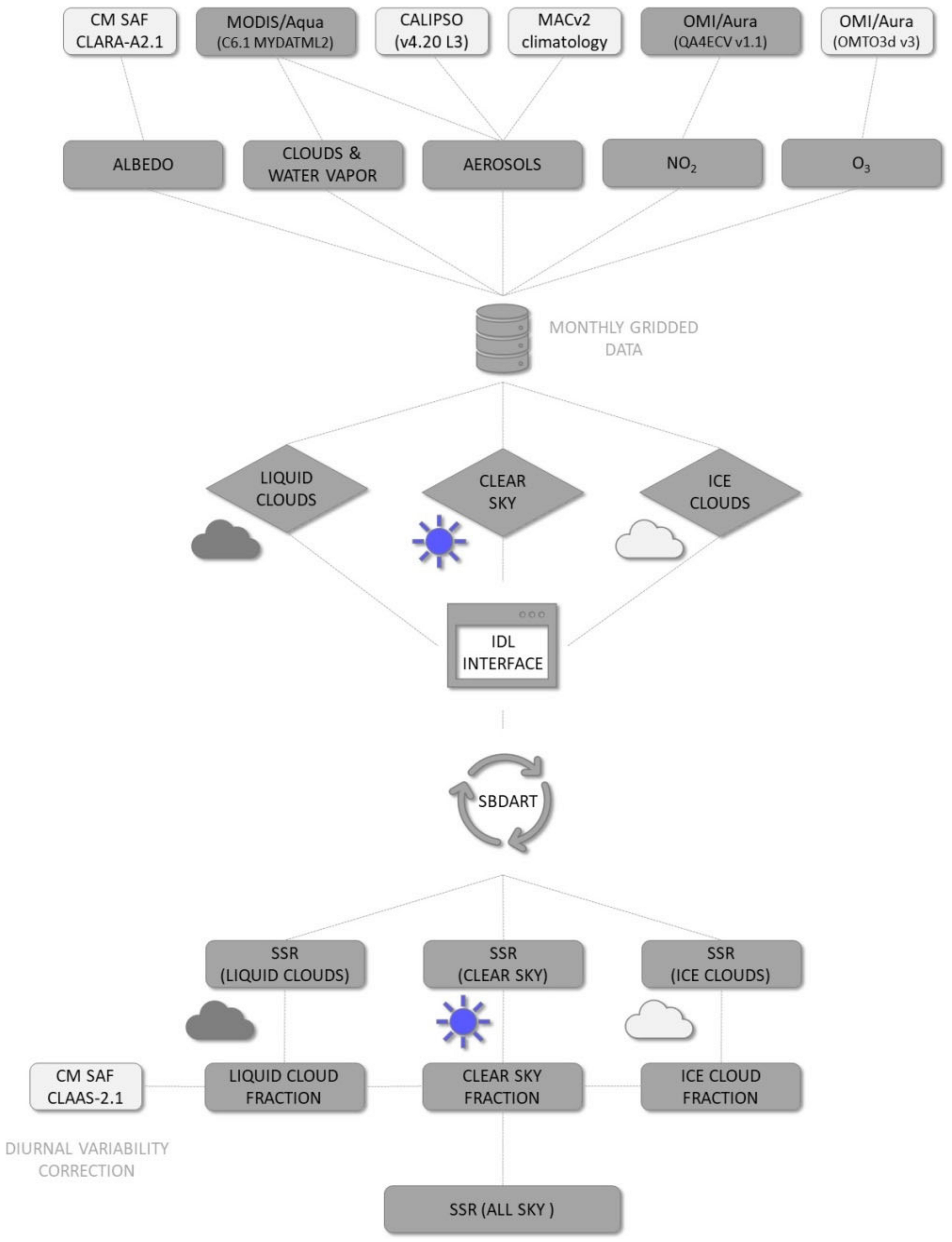
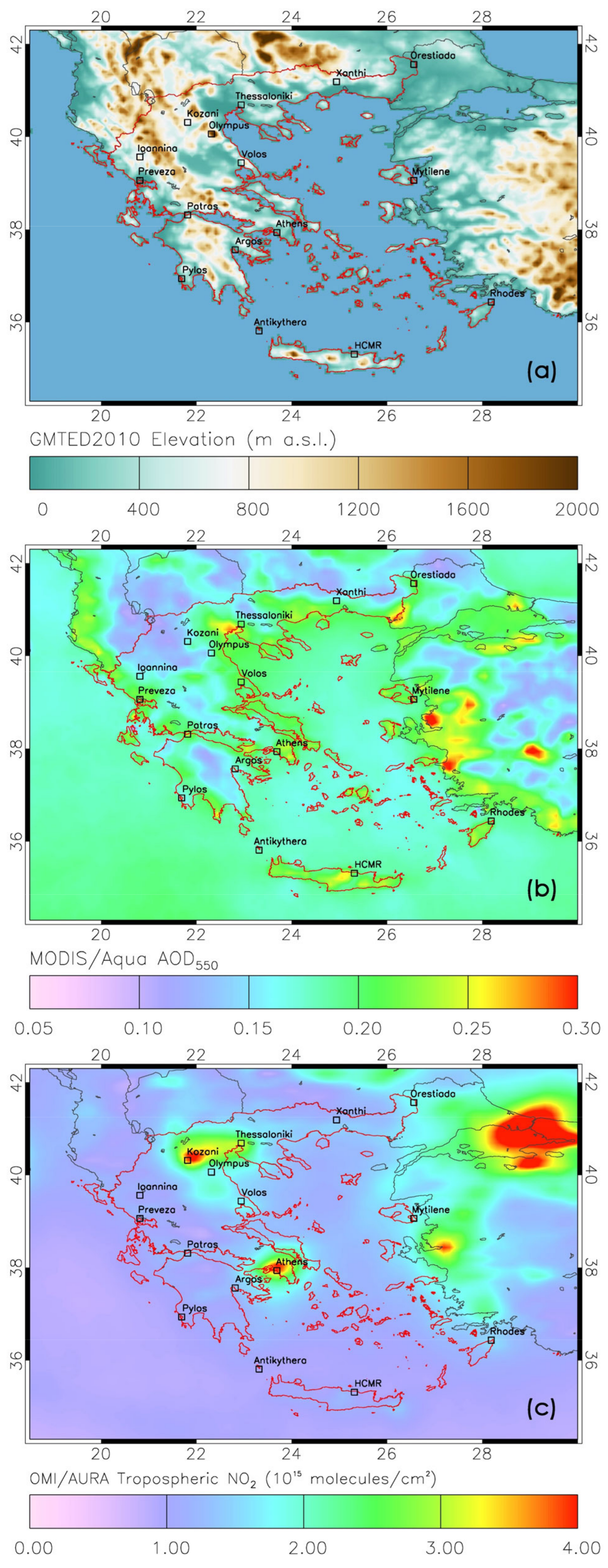
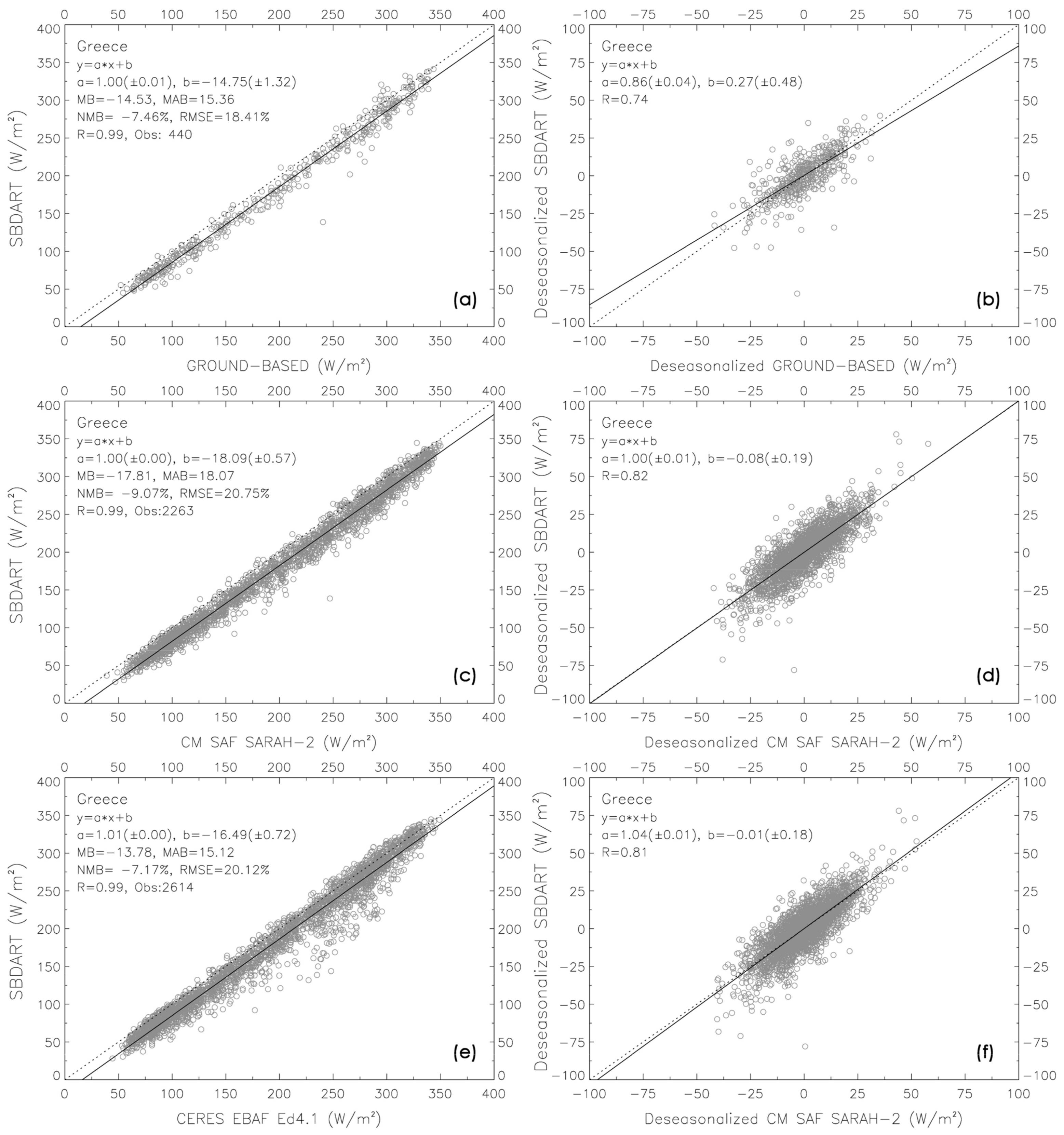
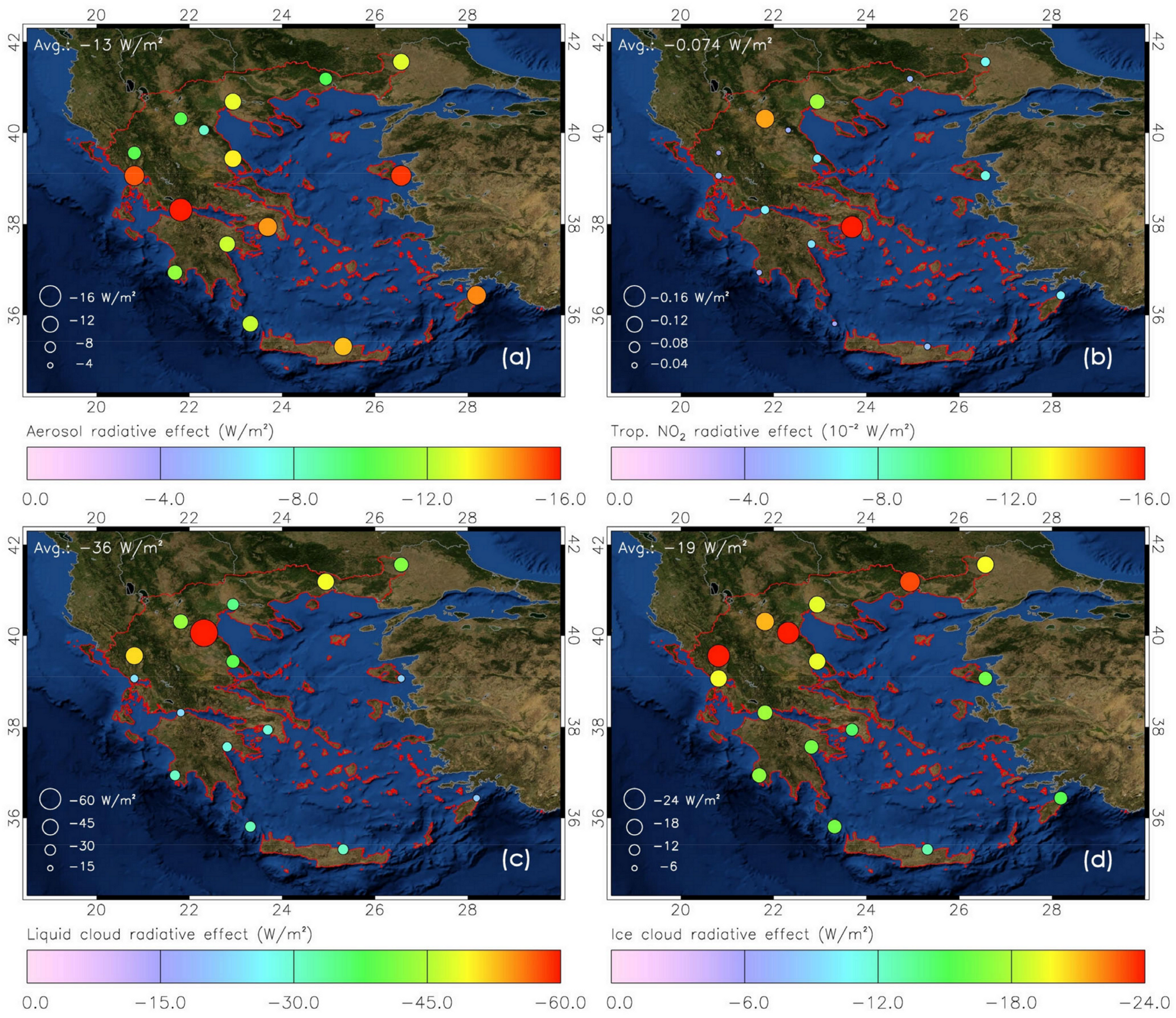
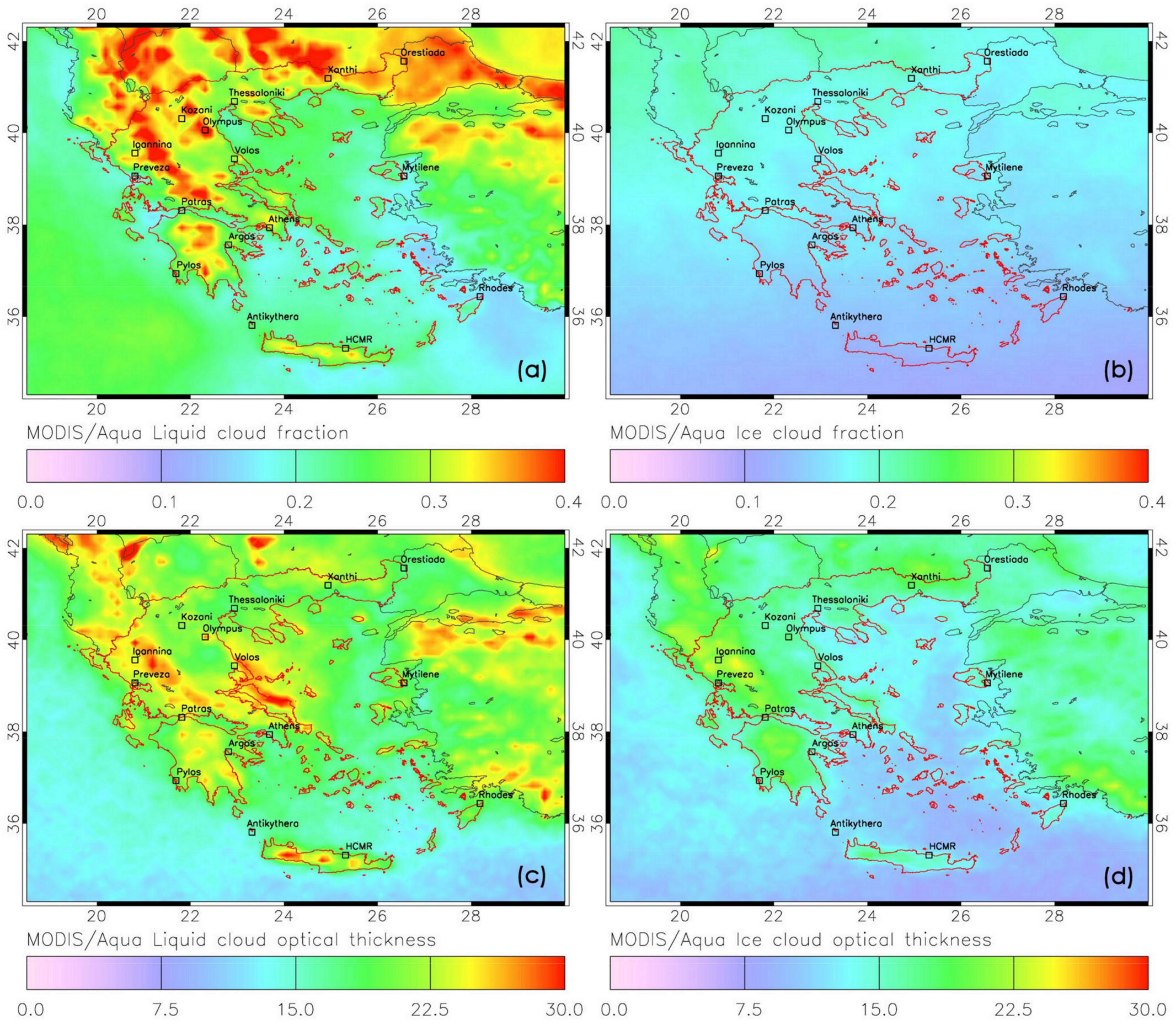
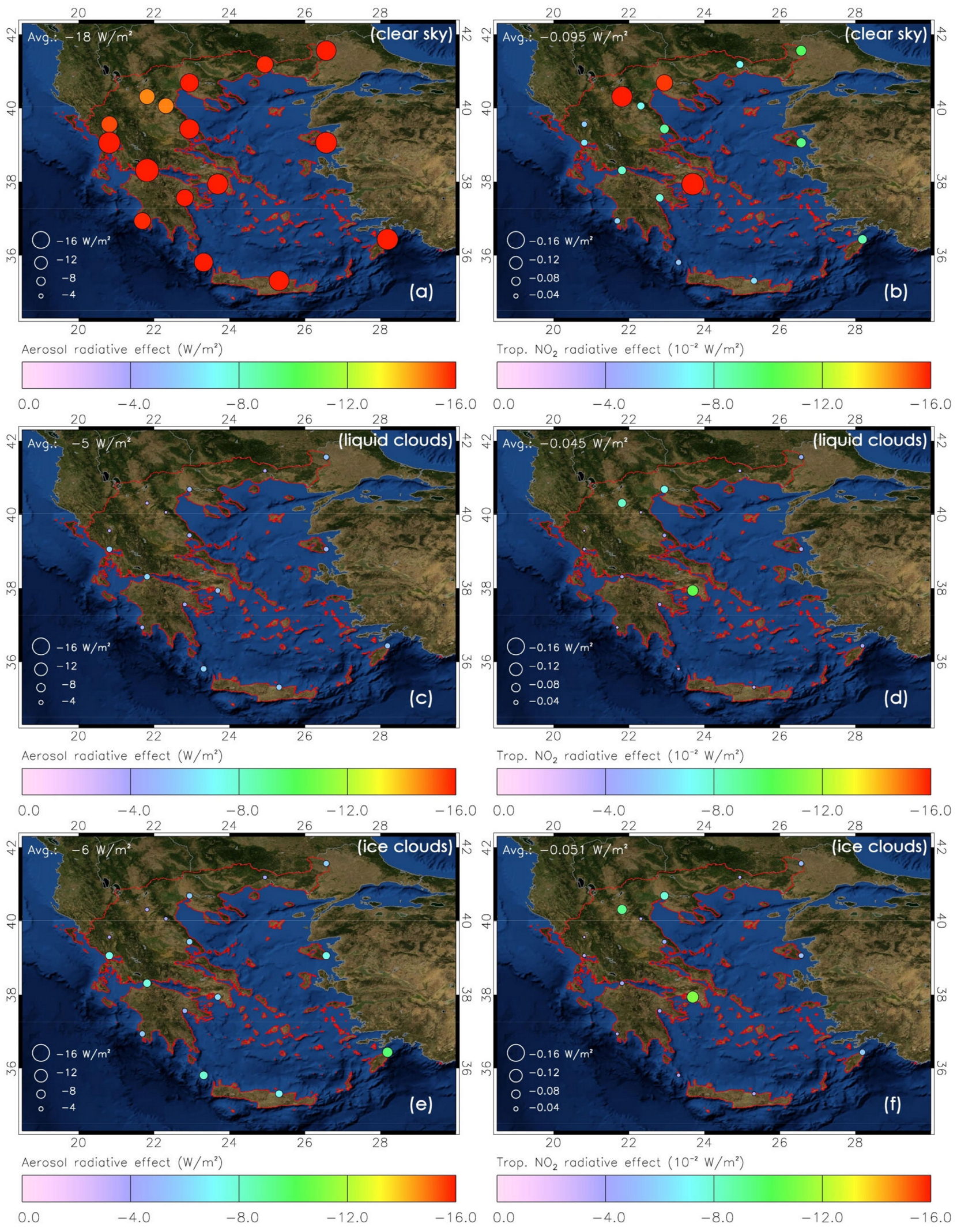
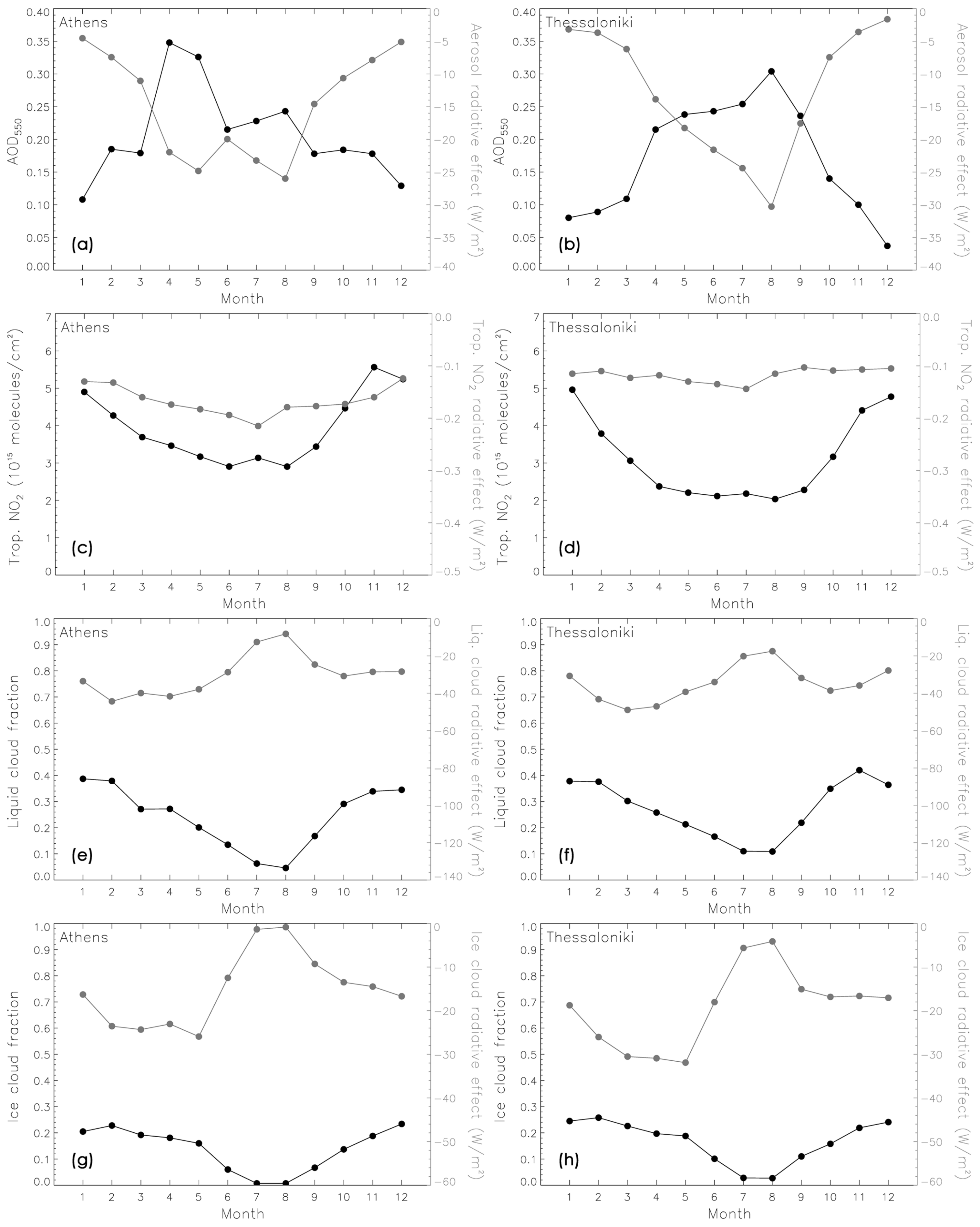
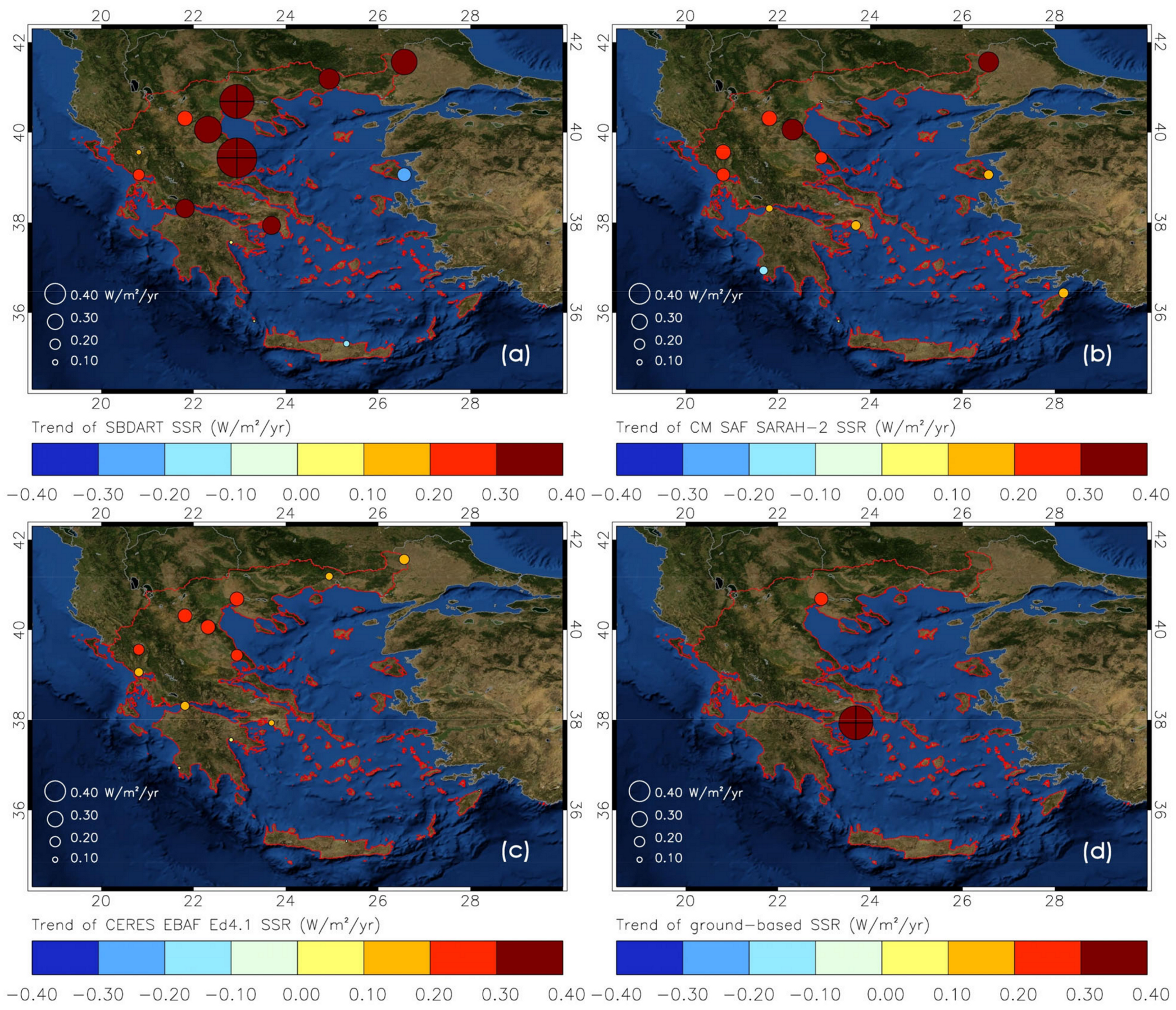
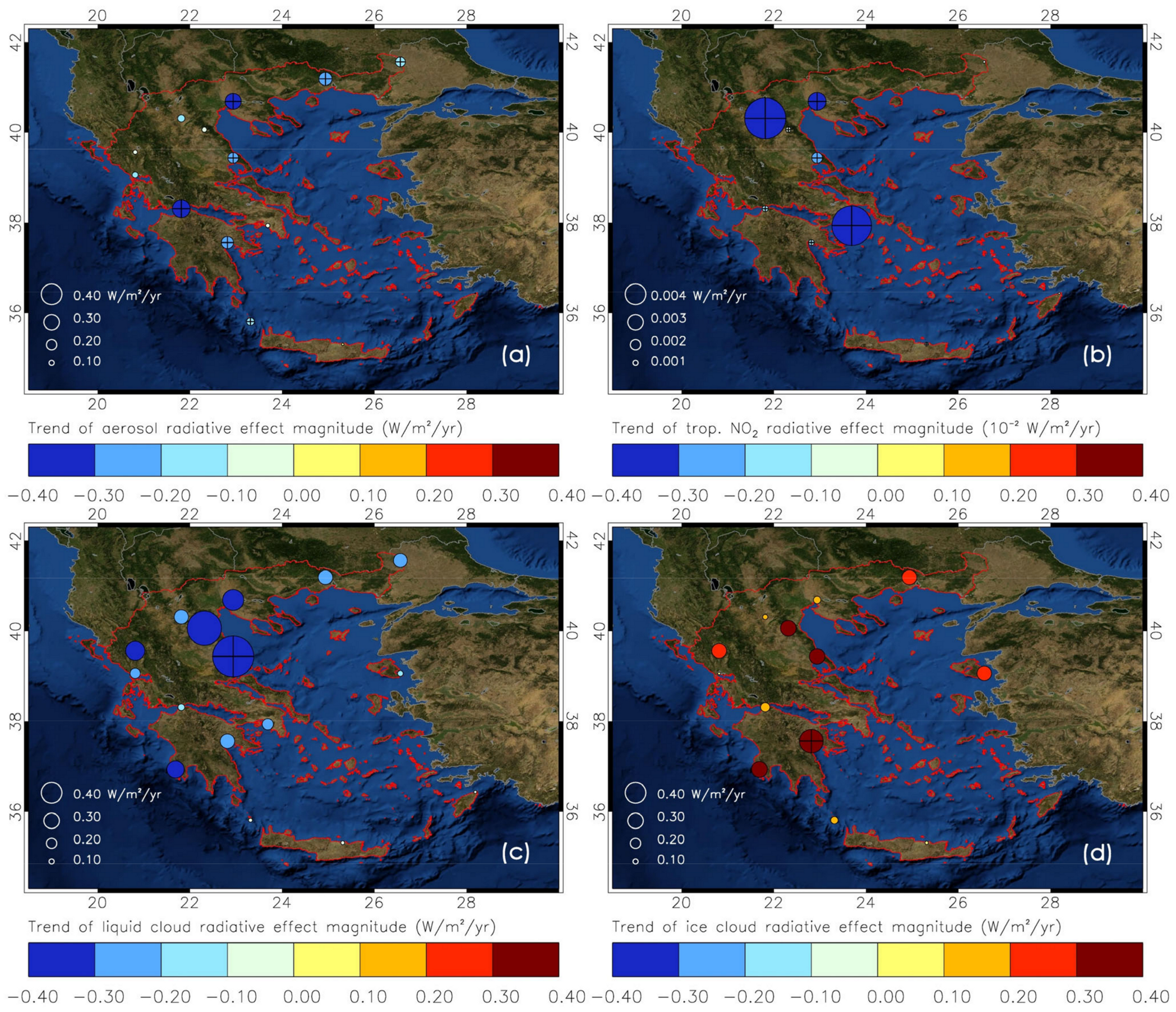
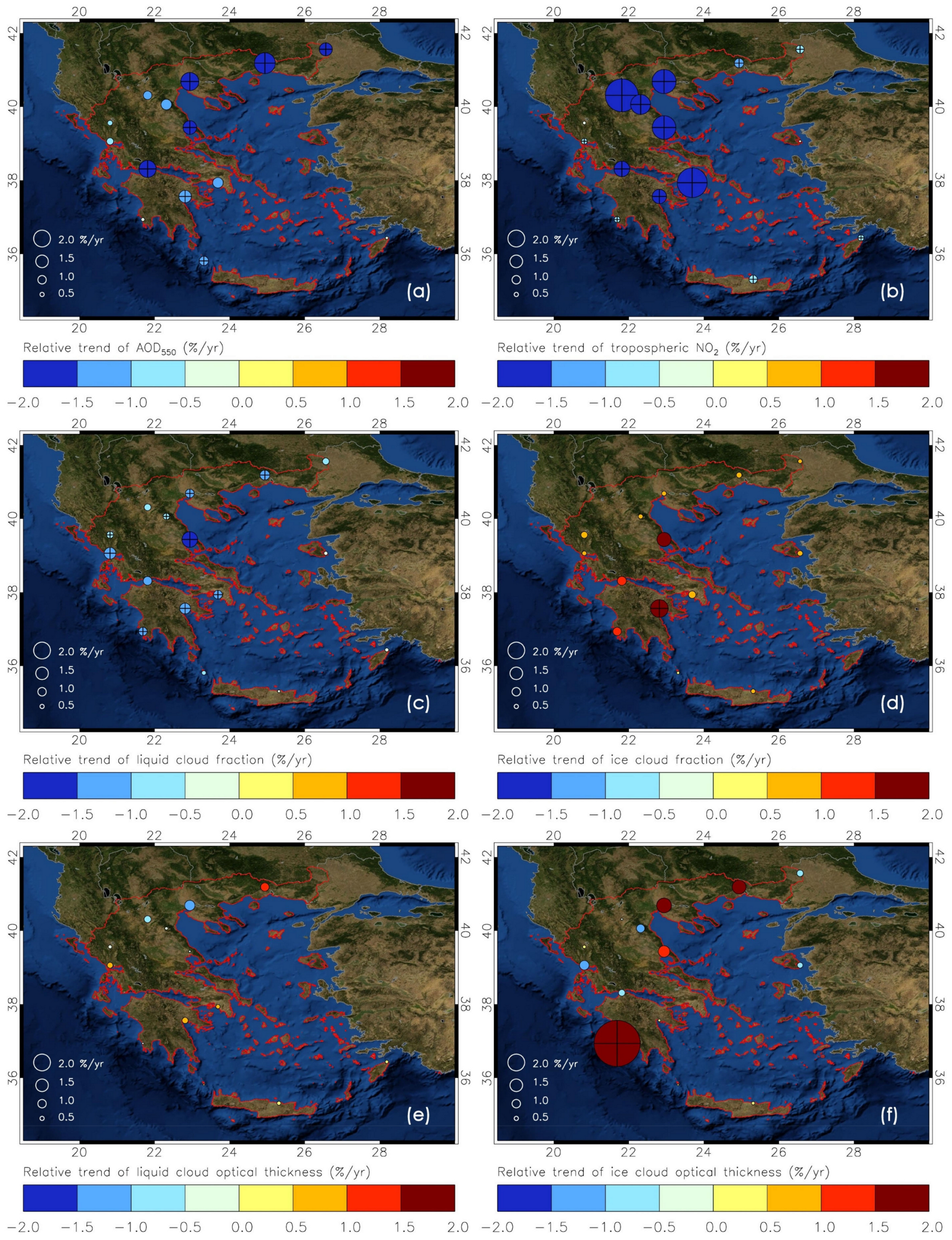
| Location | Latitude | Longitude | Urban/Rural |
|---|---|---|---|
| Antikythera | 35.8125 | 23.3125 | R |
| Argos | 37.5625 | 22.8125 | R |
| Athens | 37.9375 | 23.6875 | U |
| HCMR | 35.3125 | 25.3125 | R |
| Ioannina | 39.5625 | 20.8125 | R |
| Kozani | 40.3125 | 21.8125 | U |
| Mytilene | 39.0625 | 26.5625 | R |
| Olympus | 40.0625 | 22.3125 | R |
| Orestiada | 41.5625 | 26.5625 | R |
| Patras | 38.3125 | 21.8125 | U |
| Preveza | 39.0625 | 20.8125 | R |
| Pylos | 36.9375 | 21.6875 | R |
| Rhodes | 36.4375 | 28.1875 | R |
| Thessaloniki | 40.6875 | 22.9375 | U |
| Volos | 39.4375 | 22.9375 | U |
| Xanthi | 41.1875 | 24.9375 | R |
| Location | REaer | RENO2 | RElc | REic |
|---|---|---|---|---|
| Antikythera | −12 ± 7 | −0.043 ± 0.018 | −31 ± 17 | −16 ± 12 |
| Argos | −12 ± 7 | −0.064 ± 0.023 | −28 ± 14 | −16 ± 11 |
| Athens | −15 ± 12 | −0.166 ± 0.059 | −29 ± 15 | −15 ± 11 |
| HCMR | −14 ± 7 | −0.052 ± 0.027 | −31 ± 19 | −13 ± 11 |
| Ioannina | −10 ± 7 | −0.042 ± 0.016 | −51 ± 24 | −26 ± 16 |
| Kozani | −10 ± 9 | −0.144 ± 0.063 | −43 ± 18 | −21 ± 13 |
| Mytilene | −16 ± 9 | −0.076 ± 0.023 | −22 ± 13 | −16 ± 13 |
| Olympus | −8 ± 6 | −0.046 ± 0.014 | −79 ± 31 | −25 ± 16 |
| Orestiada | −13 ± 10 | −0.073 ± 0.025 | −42 ± 16 | −20 ± 14 |
| Patras | −18 ± 10 | −0.068 ± 0.023 | −23 ± 15 | −18 ± 13 |
| Preveza | −15 ± 9 | −0.053 ± 0.021 | −24 ± 13 | −20 ± 13 |
| Pylos | −12 ± 6 | −0.047 ± 0.020 | −31 ± 14 | −17 ± 13 |
| Rhodes | −15 ± 9 | −0.068 ± 0.029 | −21 ± 13 | −15 ± 12 |
| Thessaloniki | −13 ± 10 | −0.118 ± 0.030 | −35 ± 15 | −19 ± 13 |
| Volos | −13 ± 9 | −0.067 ± 0.024 | −39 ± 18 | −19 ± 14 |
| Xanthi | −10 ± 7 | −0.051 ± 0.022 | −49 ± 22 | −23 ± 16 |
| Location | SSR | REaer | RENO2 | RElc | REic |
|---|---|---|---|---|---|
| Antikythera | 0.05 ± 0.30 | −0.15 ± 0.06 | 0.000 ± 0.000 | −0.08 ± 0.23 | 0.15 ± 0.18 |
| (0.03 ± 0.17) | (−1.14 ± 0.41) | (0.39 ± 0.44) | (−0.25 ± 0.71) | (0.95 ± 1.16) | |
| Argos | 0.07 ± 0.22 | −0.24 ± 0.07 | −0.001 ± 0.000 | −0.28 ± 0.18 | 0.46 ± 0.13 |
| (0.04 ± 0.12) | (−1.68 ± 0.51) | (−1.56 ± 0.29) | (−0.92 ± 0.57) | (3.57 ± 1.03) | |
| Athens | 0.35 ± 0.33 | −0.08 ± 0.16 | −0.008 ± 0.001 | −0.22 ± 0.23 | 0.02 ± 0.16 |
| (0.20 ± 0.19) | (−0.55 ± 1.09) | (−3.44 ± 0.44) | (−0.7 ± 0.75) | (0.11 ± 1.08) | |
| HCMR | −0.12 ± 0.26 | 0.05 ± 0.08 | −0.001 ± 0.000 | −0.07 ± 0.21 | 0.06 ± 0.13 |
| (−0.06 ± 0.13) | (0.35 ± 0.57) | (−1.11 ± 0.31) | (−0.24 ± 0.67) | (0.52 ± 1.08) | |
| Ioannina | 0.10 ± 0.44 | −0.09 ± 0.09 | 0.000 ± 0.000 | −0.37 ± 0.35 | 0.29 ± 0.25 |
| (0.06 ± 0.24) | (−0.80 ± 0.82) | (−0.35 ± 0.57) | (−0.70 ± 0.66) | (1.24 ± 1.08) | |
| Kozani | 0.29 ± 0.35 | −0.14 ± 0.08 | −0.008 ± 0.001 | −0.28 ± 0.27 | 0.10 ± 0.17 |
| (0.18 ± 0.21) | (−1.25 ± 0.70) | (−3.91 ± 0.52) | (−0.61 ± 0.60) | (0.50 ± 0.84) | |
| Mytilene | −0.27 ± 0.27 | 0.00 ± 0.09 | 0.000 ± 0.000 | −0.11 ± 0.19 | 0.28 ± 0.17 |
| (−0.14 ± 0.14) | (−0.03 ± 0.58) | (−0.36 ± 0.42) | (−0.49 ± 0.82) | (1.99 ± 1.17) | |
| Olympus | 0.52 ± 0.45 | −0.10 ± 0.06 | −0.001 ± 0.000 | −0.67 ± 0.41 | 0.31 ± 0.23 |
| (0.37 ± 0.32) | (−1.11 ± 0.73) | (−1.87 ± 0.48) | (−0.79 ± 0.49) | (1.33 ± 0.98) | |
| Orestiada | 0.50 ± 0.33 | −0.20 ± 0.06 | −0.001 ± 0.000 | −0.27 ± 0.31 | 0.01 ± 0.20 |
| (0.32 ± 0.21) | (−1.37 ± 0.40) | (−0.64 ± 0.38) | (−0.61 ± 0.70) | (0.05 ± 1.00) | |
| Patras | 0.37 ± 0.33 | −0.35 ± 0.14 | −0.001 ± 0.000 | −0.13 ± 0.29 | 0.18 ± 0.25 |
| (0.17 ± 0.16) | (−1.74 ± 0.67) | (−1.56 ± 0.43) | (−0.56 ± 1.19) | (1.13 ± 1.53) | |
| Preveza | 0.22 ± 0.31 | −0.12 ± 0.10 | 0.000 ± 0.000 | −0.20 ± 0.19 | 0.05 ± 0.20 |
| (0.12 ± 0.17) | (−0.74 ± 0.62) | (−0.49 ± 0.40) | (−0.78 ± 0.74) | (0.28 ± 1.04) | |
| Pylos | 0.02 ± 0.25 | −0.03 ± 0.07 | 0.000 ± 0.000 | −0.34 ± 0.19 | 0.31 ± 0.18 |
| (0.01 ± 0.14) | (−0.24 ± 0.56) | (−0.65 ± 0.36) | (−1.02 ± 0.59) | (2.10 ± 1.26) | |
| Rhodes | 0.01 ± 0.29 | −0.02 ± 0.09 | 0.000 ± 0.000 | −0.06 ± 0.19 | −0.03 ± 0.20 |
| (0.01 ± 0.16) | (−0.14 ± 0.63) | (−0.57 ± 0.46) | (−0.28 ± 0.87) | (−0.19 ± 1.26) | |
| Thessaloniki | 0.67 ± 0.26 | −0.31 ± 0.09 | −0.004 ± 0.001 | −0.41 ± 0.22 | 0.14 ± 0.19 |
| (0.40 ± 0.16) | (−2.05 ± 0.62) | (−2.47 ± 0.33) | (−1.09 ± 0.57) | (0.78 ± 1.04) | |
| Volos | 0.78 ± 0.34 | −0.21 ± 0.07 | −0.002 ± 0.000 | −0.80 ± 0.29 | 0.30 ± 0.21 |
| (0.45 ± 0.20) | (−1.39 ± 0.49) | (−2.57 ± 0.41) | (−1.78 ± 0.65) | (1.77 ± 1.20) | |
| Xanthi | 0.40 ± 0.37 | −0.26 ± 0.06 | 0.000 ± 0.000 | −0.28 ± 0.29 | 0.29 ± 0.23 |
| (0.26 ± 0.24) | (−2.16 ± 0.46) | (−0.67 ± 0.38) | (−0.55 ± 0.57) | (1.39 ± 1.08) |
| Location | AOD550 | Trop. NO2 | CFL | COTL | CFI | COTI |
|---|---|---|---|---|---|---|
| Antikythera | −0.002 ± 0.001 | 0.00 ± 0.00 | −0.001 ± 0.001 | 0.025 ± 0.131 | 0.000 ± 0.001 | 0.025 ± 0.229 |
| (−1.11 ± 0.35) | (0.09 ± 0.32) | (−0.53 ± 0.45) | (0.20 ± 1.09) | (0.34 ± 0.82) | (0.21 ± 1.95) | |
| Argos | −0.003 ± 0.001 | −0.03 ± 0.00 | −0.003 ± 0.001 | 0.129 ± 0.112 | 0.003 ± 0.001 | 0.055 ± 0.281 |
| (−1.500 ± 0.520) | (−1.72 ± 0.27) | (−1.3 ± 0.48) | (0.74 ± 0.64) | (2.13 ± 0.95) | (0.32 ± 1.64) | |
| Athens | −0.003 ± 0.003 | −0.19 ± 0.02 | −0.003 ± 0.001 | 0.079 ± 0.138 | 0.001 ± 0.001 | 0.008 ± 0.210 |
| (−1.25 ± 1.24) | (−3.57 ± 0.40) | (−1.06 ± 0.41) | (0.52 ± 0.91) | (0.88 ± 0.97) | (0.05 ± 1.49) | |
| HCMR | 0.000 ± 0.001 | −0.01 ± 0.00 | −0.001 ± 0.001 | 0.069 ± 0.101 | 0.001 ± 0.001 | 0.052 ± 0.255 |
| (0.12 ± 0.73) | (−0.99 ± 0.28) | (−0.35 ± 0.52) | (0.48 ± 0.69) | (0.54 ± 1.00) | (0.40 ± 1.94) | |
| Ioannina | −0.001 ± 0.001 | 0.00 ± 0.01 | −0.003 ± 0.001 | −0.102 ± 0.137 | 0.001 ± 0.001 | 0.095 ± 0.339 |
| (−0.62 ± 0.77) | (−0.40 ± 0.54) | (−0.83 ± 0.41) | (−0.45 ± 0.60) | (0.81 ± 0.75) | (0.40 ± 1.44) | |
| Kozani | −0.002 ± 0.001 | −0.21 ± 0.03 | −0.003 ± 0.002 | −0.186 ± 0.161 | 0.000 ± 0.001 | −0.047 ± 0.328 |
| (−1.03 ± 0.71) | (−3.95 ± 0.52) | (−0.82 ± 0.48) | (−0.83 ± 0.72) | (0.04 ± 0.69) | (−0.26 ± 1.80) | |
| Mytilene | 0.000 ± 0.001 | −0.01 ± 0.01 | −0.001 ± 0.001 | −0.013 ± 0.201 | 0.001 ± 0.001 | −0.098 ± 0.237 |
| (−0.17 ± 0.52) | (−0.30 ± 0.40) | (−0.46 ± 0.59) | (−0.07 ± 1.07) | (0.65 ± 0.85) | (−0.68 ± 1.64) | |
| Olympus | −0.002 ± 0.001 | −0.05 ± 0.01 | −0.004 ± 0.002 | −0.106 ± 0.147 | 0.001 ± 0.001 | −0.218 ± 0.294 |
| (−1.27 ± 0.70) | (−2.38 ± 0.49) | (−0.78 ± 0.38) | (−0.38 ± 0.53) | (0.57 ± 0.71) | (−1.01 ± 1.36) | |
| Orestiada | −0.003 ± 0.001 | −0.02 ± 0.01 | −0.003 ± 0.002 | −0.004 ± 0.123 | 0.001 ± 0.002 | −0.137 ± 0.220 |
| (−1.57 ± 0.42) | (−0.98 ± 0.42) | (−0.81 ± 0.47) | (−0.02 ± 0.72) | (0.53 ± 0.90) | (−0.79 ± 1.27) | |
| Patras | −0.005 ± 0.002 | −0.03 ± 0.01 | −0.002 ± 0.001 | 0.023 ± 0.224 | 0.002 ± 0.001 | −0.133 ± 0.361 |
| (−2.06 ± 0.63) | (−1.88 ± 0.42) | (−1.05 ± 0.56) | (0.13 ± 1.24) | (1.09 ± 0.79) | (−0.80 ± 2.16) | |
| Preveza | −0.002 ± 0.001 | −0.01 ± 0.00 | −0.003 ± 0.001 | 0.132 ± 0.235 | 0.001 ± 0.001 | −0.192 ± 0.225 |
| (−0.84 ± 0.65) | (−0.72 ± 0.36) | (−1.41 ± 0.48) | (0.70 ± 1.25) | (0.56 ± 0.71) | (−1.14 ± 1.34) | |
| Pylos | −0.001 ± 0.001 | −0.01 ± 0.00 | −0.003 ± 0.001 | −0.043 ± 0.15 | 0.001 ± 0.001 | 0.615 ± 0.252 |
| (−0.45 ± 0.56) | (−0.72 ± 0.30) | (−1.04 ± 0.41) | (−0.25 ± 0.87) | (1.02 ± 0.90) | (5.53 ± 2.27) | |
| Rhodes | −0.001 ± 0.001 | −0.01 ± 0.01 | −0.001 ± 0.001 | 0.067 ± 0.249 | 0.000 ± 0.001 | 0.018 ± 0.223 |
| (−0.35 ± 0.53) | (−0.73 ± 0.33) | (−0.46 ± 0.58) | (0.40 ± 1.47) | (0.01 ± 0.94) | (0.13 ± 1.65) | |
| Thessaloniki | −0.005 ± 0.001 | −0.11 ± 0.01 | −0.003 ± 0.001 | −0.236 ± 0.162 | 0.001 ± 0.001 | 0.238 ± 0.25 |
| (−2.18 ± 0.58) | (−2.89 ± 0.36) | (−1.06 ± 0.44) | (−1.24 ± 0.85) | (0.58 ± 0.85) | (1.77 ± 1.86) | |
| Volos | −0.004 ± 0.001 | −0.06 ± 0.01 | −0.006 ± 0.002 | −0.054 ± 0.141 | 0.003 ± 0.001 | 0.194 ± 0.233 |
| (−1.65 ± 0.45) | (−2.83 ± 0.35) | (−1.88 ± 0.50) | (−0.28 ± 0.72) | (1.70 ± 0.95) | (1.38 ± 1.67) | |
| Xanthi | −0.005 ± 0.001 | −0.02 ± 0.01 | −0.004 ± 0.002 | 0.188 ± 0.138 | 0.001 ± 0.002 | 0.287 ± 0.213 |
| (−2.51 ± 0.46) | (−1.14 ± 0.39) | (−1.19 ± 0.41) | (1.03 ± 0.76) | (0.68 ± 0.96) | (1.66 ± 1.23) |
Publisher’s Note: MDPI stays neutral with regard to jurisdictional claims in published maps and institutional affiliations. |
© 2021 by the authors. Licensee MDPI, Basel, Switzerland. This article is an open access article distributed under the terms and conditions of the Creative Commons Attribution (CC BY) license (https://creativecommons.org/licenses/by/4.0/).
Share and Cite
Alexandri, G.; Georgoulias, A.K.; Balis, D. Effect of Aerosols, Tropospheric NO2 and Clouds on Surface Solar Radiation over the Eastern Mediterranean (Greece). Remote Sens. 2021, 13, 2587. https://doi.org/10.3390/rs13132587
Alexandri G, Georgoulias AK, Balis D. Effect of Aerosols, Tropospheric NO2 and Clouds on Surface Solar Radiation over the Eastern Mediterranean (Greece). Remote Sensing. 2021; 13(13):2587. https://doi.org/10.3390/rs13132587
Chicago/Turabian StyleAlexandri, Georgia, Aristeidis K. Georgoulias, and Dimitris Balis. 2021. "Effect of Aerosols, Tropospheric NO2 and Clouds on Surface Solar Radiation over the Eastern Mediterranean (Greece)" Remote Sensing 13, no. 13: 2587. https://doi.org/10.3390/rs13132587
APA StyleAlexandri, G., Georgoulias, A. K., & Balis, D. (2021). Effect of Aerosols, Tropospheric NO2 and Clouds on Surface Solar Radiation over the Eastern Mediterranean (Greece). Remote Sensing, 13(13), 2587. https://doi.org/10.3390/rs13132587





